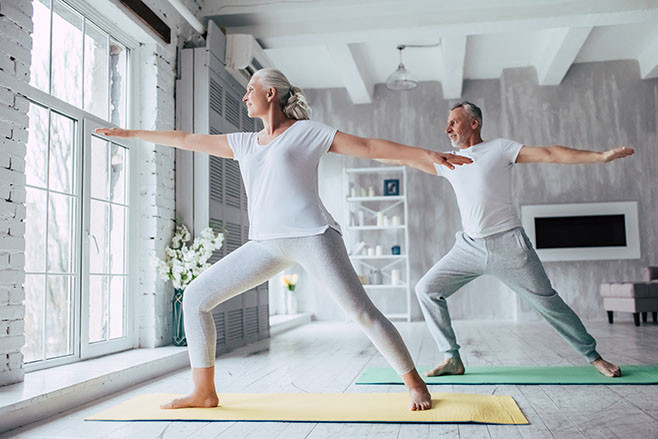
Parkinson’s Disease (PD) is a chronic, progressive condition that claims many victims each year. Among its effects are debilitating motor symptoms, including tremors, rigidity, bradykinesia (decelerated movement) and postural and balance instability.
In addition, people with PD often suffer muscular weaknesses, increased fatigue and chronically stiff joints.
Exercise is important for everybody: we should all partake of some form. Moreover, this article doesn’t need to be applicable to those with PD. Many degenerative or debilitating medical conditions can benefit from exercise, and it’s always worth talking to your physician about what exercise can do for you.
I just want to use PD as an example of just how important regular exercise can be.

The benefits
Regular exercise has many protective effects. These range from the reduction of chronic illnesses to the promotion of good posture. For those worrying about PD, it may reduce the risk of developing in the first place. For those suffering with PD, it can help to relieve many of the motor symptoms of PD, alongside the negative mental health aspects that often come hand in hand.
I know this for sure: I have personally trained some really quite inspirational people suffering with PD and similar illnesses. They all responded positively to exercise. In some cases, where clients of mine were told they would be wheelchair-bound within a few years of diagnosis, I had them up and about a decade into their treatment.

Exercise isn’t a panacea, by any stretch of the imagination. It only arrested the onset of each condition in each case. But it does make people happier and more stable for longer than they would be were they to stay sedentary.
Exercise and Parkinson’s Disease
Looking at PD specifically, exercise not only improves muscle strength and function, it has additional benefits, including:
- Reduced motor symptoms, improving bradykinesia, and postural instability
- Enhanced efficacy of levodopa therapy
- Improved heart and lung capacity and endurance, all of which commonly decline rapidly through PD
- Improved gait disturbances
- Improved function, which is once more a big area hit by PD
- Improved quality of life

Types of exercise
Various types and styles of exercise can benefit somebody with PD, and I’ll go through some of these below. Balance, stamina, muscular strength and peace of mind are all important factors to bear in mind when choosing training methods, and each should be given space in a well-rounded routine.
Alongside type, consistency and intensity are important. Obviously, the earlier on a PD sufferer is in their disease, the more consistent and intense they will be able to be. As the disease progresses, and muscular strength, fitness and coordination begin to deteriorate, intensity will have to drop.
With clients suffering from diseases such as PD, it’s common enough to begin on a typical 3 session week, at an hour or so per session. After a couple of years, this may have been cut down and down, until we are only meeting for 3 20-30 minute sessions. This is normal, as much as such a situation can be described as normal.

Consistency should not change if at all possible, however. The hour can drop to 20-30 minutes, but I will still want to see them 3 days per week. They can cancel if they need to- last minute, at times- but I will still plan and book them in for these sessions. Willpower will flag- it’s a finite resource- and so people will have to rely more and more on habit: keep to your old workout habits, and you’ll be amazed at how long you can continue to train.
Random movement
Exercises should be varied and should incorporate changing directions through unplanned movements, cardio, balance, strength training and rhythmical exercises. This is a real struggle for people with PD, and so should be central to any plan to keeping them well-trained.
These exercises all require someone to keep changing up their pace, tempo and direction:
- Walking, hiking or jogging
- Racket sports
- Yoga or Tai Chi (I have had particular success training clients in the latter)
- Outdoor cycling
- Dancing
- Swimming

-random movement helps you to retain real-world movement patterns
Planned, repeated movements
These will be exercises that often require balance over a series of repeated movements. I’ve found best results often come whilst the PD sufferer is listening either to repetitive, beat-based music, or often even just a metronome:
- Cycling on a static bike
- Weightlifting using light to medium weights
- Swimming laps in the same stroke
- Slow walking or jogging on a treadmill or track

-weightlifting is for everybody and brings its own rewards
Balance exercises
This isn’t really its own category as such. Yoga, tai chi weightlifting and dancing will all help somebody to retain or even build on their natural balance. Having somebody control their body through space is vital for anybody losing coordination in the way that a PD sufferer typically does.
Rather than setting aside specific time for balance training, a PD sufferer should do it throughout your whole exercise regimen. They should stay mindful of their presence, of how they move, of how they feel during certain movements, and of which exercises/ways of moving best suit their needs.

Yoga and tai chi are likely the best candidates for this kind of benefit, but I have also achieved great results with people in the weights room.
The take-home
Stay active, always. No matter what your health does to you, there will be an amount of physical exertion of which you are capable. Do this much, then do a little bit more. You will arrest your body’s decline if you have any kind of degenerative disease. If you’re in full health, you may even save yourself from conditions like PD.
Whatever your situation, you will be stronger, healthier, calmer and more balanced for living an active lifestyle: whatever life throws at you, make sure you are well equipped.

Always consult your physician prior to and during exercise if you have any medical concerns. Working with a relevant healthcare professional will make sure that you stay safe and keep your exercise schedule optimised.




